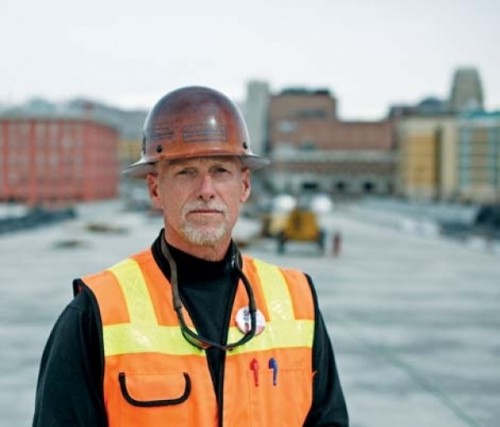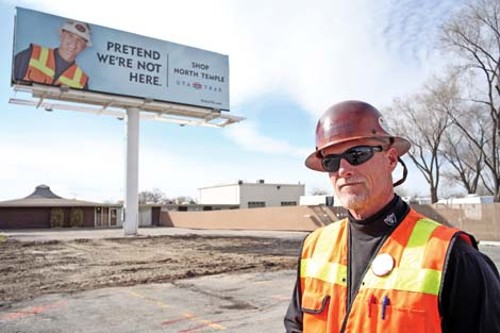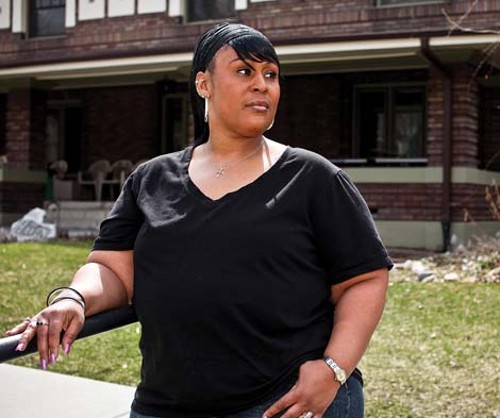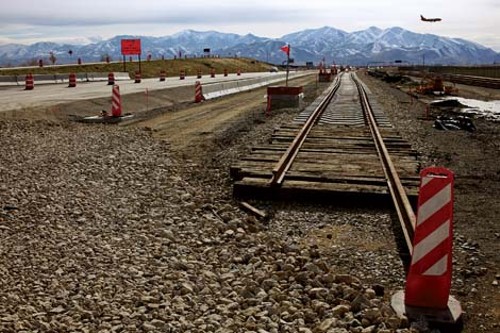North Temple: Rehab Boulevard
North Temple’s overhaul may crush some dreams and inspire new ones.
By Stephen Dark @stephenpdarkHis father, Mike Howard Sr., brought his 33-year-old son to Provo, where most of his family resides. But the younger Howard, by then saddled with a 20-year criminal and drug-addiction history, continued on his downward slide. He hung out with prostitutes on North Temple in Salt Lake City’s west side and, in exchange for protecting them, they introduced the long-time cocaine addict to heroin, injecting speedballs (cocaine and heroin combined). “It was the most beautiful thing I’d ever done,” he says. “Once the head rush of the coke was gone, the heroin was like music washing over your body.”
For four years, Howard worked North Temple, between 600 West and 2400 West—buying, selling and using drugs—or, with two other addicts, watching where drug dealers kept their stashes and then robbing them.
He moved from one run-down, single- or two-story motel to another, overdosing three times in one motel, doing drugs with prostitutes in another. He financed his habit partly by stealing from a Home Depot or a Nordstrom and then returning the items. Intermittently, he went to a drug-rehab program or the Salvation Army, but only to clean himself up for a week or so before getting back on the street.
“We always viewed him as extremely capable, of having a great potential,” Howard Sr. says. But by 1999, “We really felt it was a matter of months before we would be at his funeral.”
In fall 1999, “seeing how disappointed and scared mom and dad were,” Howard entered his “last chance,” The Haven, a Salt Lake County-funded rehab known for its confrontational methods. Recovering addicts struggle through a 90-day program, which they only get one shot at.
For seven months, Howard was clean and sober, but after a woman, also in recovery, declined to go out with him, “I went back to my first love: slamming speedballs.”
In an apartment his father had rented for him, located on South Temple directly across from The Haven, Howard shot up while looking out the window at the bright lights of the rehab center and listening to the laughter and energized conversation of addicts working through recovery. “It was the darkest, blackest place I’ve ever been,” Howard recalls. “I could feel their joy, their laughter in recovery. I had thrown it all away.”
When his father checked on Howard, he found him all but dead on the floor of the apartment. Howard regained consciousness after doctors removed ligaments from his thigh. They had disconnected his leg from his hip in order to drain and scrape the bone free of a staph infection he had gotten by injecting drugs. Left untreated, the infection would have killed him.
On May 2, 2000, a doctor told Howard the operation was pointless. “You are going to go out and use, and you are going to die,” the doctor predicted. That same day, Howard had a vision of his recently deceased grandfather. In the past, his grandfather had always told him, “Stay in there and keep pitching.” But this time, Howard says, in his delirium, he saw a look of resignation on his grandfather’s face. “It was the saddest thing.”
WHEEL OF FATE
On May 3, 2011, Howard will have completed 11 years clean and sober. Drive down North Temple, however, and you will still see him there, day and night. Now, instead of a haggard wraith scoring dope in the shadows, his healthy features adorn a billboard overlooking street traffic next to the words “Pretend we’re not here.” Howard is general superintendent for general contractor Stacy and Witbeck, hired by Utah Transit Authority to complete the four-year North TRAX project. Howard is supervising the 18 crews of 200 workers on the $360 million light-rail venture that will connect Salt Lake City International Airport with downtown Salt Lake City and beyond. It will also turn at least part of North Temple into what the city calls “a grand boulevard” with expanded sidewalks, colored street surfaces, bicycle lanes and public art, all bracketed, Salt Lake City hopes, by new residential and commercial development.
“Now, I’m looking down on what’s going on,” Howard says about the billboard UTA asked him to do. “Eleven years ago, I was looking up from the depths of hell.”
As Howard and his crews bring North Temple into the 21st century, the future of the twilight world that North Temple’s addicts and prostitutes inhabit is inevitably in question. The startling transformation now facing the dark side of the street Howard once knew so well is apparent not only in the physical street upgrades that he supervises but also in the few new businesses, like Viva’s grocery market, that have chosen to bet on North Temple’s future. But not all the businesses on North Temple are willing or even able to afford to make the leap to the notion of a “grand boulevard.”
Howard’s switch from a hard-core heroin junkie to supervising North Temple’s makeover “is a huge turn of the wheel of fate,” says Bill Coker, former movie producer turned co-owner, with wife Lucy Cardenas, of North Temple’s Mexican restaurant Red Iguana and its recent offspring Red Iguana 2. Of Howard’s turnaround, Coker—a self-appointed spokesman for North Temple’s revitalization—says Howard “has come back to a neighborhood that’s not in the best of shape and finds himself able to help that community.” That help, in part, has focused on coordinating relentlessly with business owners up and down North Temple to ensure his crews are as minimally invasive and obstructive as possible. “His personality and magnanimity has made it very easy for many of us to go to him with our concerns,” says the Pentecostal Church’s Pastor Ronald Rice.
One irony that accompanies Howard’s return to the street he thought he might die on is that the progress he is spearheading as a contractor may well mark the doom of the very motels he used to frequent as a criminal. Salt Lake City’s Community and Economic Development director, Frank Gray, says that as the pace of development increases, so the land value will rise, eventually forcing out businesses that aren’t interested in investing or growth. “We will let the [property] market do that,” he says.
If market forces weren’t bad enough, many of the mom & pop stores, already embattled by the recession, have found themselves encumbered for the last two years with a street full of construction cones. They’ve also had to deal with the viaduct connecting the street to downtown Salt Lake City being closed for two years, providing significant obstacles to those seeking to make it to their doors. “You can walk out at high noon, shoot a cannon down the street and not hit anything,” says local realtor, Dave Galvan. The final insult for some property owners was learning in February 2010 that they faced thousands of dollars in taxes for the lighting and landscaping upgrade. After resistance from many of the smaller businesses, the city scaled back its plans for a grand North Temple boulevard so it would run only from 600 West to Redwood, but that didn’t forestall an October 2010 lawsuit filed by aggrieved local businesses alleging civil rights violations by the city.
Attractive artists’ renditions from Salt Lake City picture a future North Temple of pedestrians frequenting a tree-lined boulevard with new office and apartment developments, a transformation aided in part by tax incentives and development loans courtesy of a forthcoming RDA which, Gray says, may be inked in the summer. That vision contrasts with the street’s current composition of foot traffic—veterans, homeless people and prostitutes—according to business owner Rick Clarke, of North Temple’s That Sandwich Shop. He sarcastically questions whether the current pedestrians “justify” the newly built 10-foot sidewalk outside his business. Talk to those who own struggling businesses on North Temple, and though some have a vision of a luminous future if they can just survive the next two years, others, like The Encore Grill’s Jim Tsoufakis, are less optimistic. He doubts his 14-year-old family diner can survive the impact of the recession, two more years of construction cones and the vagaries of running a business by North Temple. “I feel trapped like a rat,” Tsoufakis says, “Nowhere to go, no escape.”
SWITCHING ADDICITONS
In the 1930s, North Temple was “the primary road into town,” Gray says. Lined with small motels for visitors coming into Salt Lake City or heading out to the desert and Reno, the opening of interstates 80 and 15 “diminished North Temple as an entryway to the city. Since the early 1950s, it was sliding downhill.” For the past few decades, it has languished under a dusty pall, part of a west side that residents argue was long forgotten by city planners and budget directors.
Along with the vacant lots, a plasma center, auto-parts stores, a trailer park and small Mexican and Central American restaurants, the many blocks of government offices, the 65-acre Utah State Fairpark and the red-brick walls of Rocky Mountain Power’s offices only add to the urban cloud of desolation that hovers over North Temple’s six lanes. While there are bright cultural spots such as the Mestizo Coffee House and art center, much of the street’s downtrodden personality and reputation for crime stems from the shady, ramshackle motels that dot its length. A number of them are all too frequently awash in the red-and-blue lights of a police car, an ambulance responding to an overdose or reports of a wanted felon holed-up in a room.
In the spring of 2000, Howard’s journey back to North Temple began when, still limping from his life-saving operation, he took a job as a flagger at Stacy and Witbeck, working on the 400 South light-rail TRAX construction project. “It was the first real job in my life,” he says. He switched his addiction from drugs to work. His passionate loyalty 10 years later to Stacy and Witbeck stems, he says, from knowing, “what they did for me.”
In July 2001, Howard was promoted to traffic-control supervisor. From there, Stacy and Witbeck sent him first to San Diego, then Arizona, where he was assistant superintendent of a light-rail construction project. In 2008, Stacy and Witbeck offered him several projects in Denver, Houston and Salt Lake City. Howard chose North Temple because it would bring him close to his family and, he admits, “I was intrigued to work on a project where I used to have other interests on this street.”
Bill Coker learned that Howard and his crews were closing down North Temple just 18 months after he and his wife, Lucy Cardenas, had bought Salt Lake City’s most famous “hole in the wall” Mexican eatery, the 40-year-old Red Iguana, from Cardenas’ father. Coker describes the restaurant as “four little rabbit-warren dining rooms which feed 700 people a day.” When he got a mailer about the new airport line, he realized he faced three years of construction outside his front door. He decided to “embrace it, shape it, make it successful, and help mitigate the impact of the project on this business.” Part of Coker’s mitigation was to open Red Iguana 2 a few blocks away, to “create a revenue stream to sustain itself if things got really difficult,” while also investing in a neighborhood where he and Cardenas had recently bought a house.
One example Coker offers that North Temple’s revitalization is already in the works is Pipa, a narrow cocktail bar-cum-tapas restaurant run by David Tran. He’s the son of the owners of East Sea, a mom & pop Asian restaurant next door to Pipa, whose kitchen he shares. Coker admires Tran’s boldness in employing a hip, urban décor and Asian-fusion tapas menu, contrasting Pipa’s appeal to international sophisticates to Red Iguana’s commitment to authentic Mexican cuisine.
While house music plays in the background and embedded lights in the walls slowly change color, 27-year-old Tran expresses his excitement for what “the new North Temple can be. Hopefully with the redevelopment of the area, it will clean up and be an extension of what downtown is. We are definitely banking on TRAX blowing up the area [economically].”
Tran wasn’t overly enthusiastic about his new neighbor, Viva. The Hispanic grocery market has a 60-foot-long butcher counter and a third of its space dedicated to fresh produce. “It’s an effort to recapture the small scale, community-involved business,” Coker says. But Tran and others in the neighborhood had hoped for a Whole Foods or a Sunflower Farmers Market. “I wasn’t thrilled by the grand opening” of Viva in February, he says. “Latin music was blasting, the parking lot was filled, but we were hoping to try to attract more of a diverse crowd than just Latinos.” His parents’ restaurant next door, however, he adds, “got a big boost. I didn’t see any of it.”
EMPTY TABLES
On the opposite end of North Temple, Lofte Daoua and Jim Tsoufakis lack Coker and Tran's optimism. Six years after Daoua had opened a successful sports bar in 2001 at the airport end of North Temple, he then opened Lofte’s Pizzeria & Coffee in an adjacent, renovated garage. Now he wants to sell the languishing pizzeria, but can’t find a buyer. While he can’t wait for the light-rail to be completed, “the problem is how you suffer those four years. It’s a matter of survival.” With corporations’ travel expenses cut to the bone by the recession and construction sealing off access to his street for days at a time, Daoua is faced with something he has never had to deal with before. “This is the most failure I have in my life,” he says.
Daoua knows the only hand-up he can expect is the promise of a bright future several years down the line from TRAX advocates. “Someone here is starving and they say you will eat filet mignon in a few years,” he says. “But I want burger now, something to fill my stomach.”
Daoua’s neighbor, Encore Grill’s Tsoufakis, looks gloomily around the booths of his empty diner. “You can see for yourself,” he says about the impact on his business of construction. Admittedly, he says, business was bad at the beginning of the North TRAX project. After 9/11, lunchtime customers, especially airport employees, stopped coming because of security issues. Then, when the state switched to four-day work weeks with half-hour lunches, business from the local state offices vanished. While the city offered a five-year, $20,000 mitigation loan to North Temple businesses, “I’d just be digging a deeper hole to survive,” he says.
WHO WILL PAY?
Muriel Wilson argues it’s Salt Lake City that is hammering the last nail into the coffin of west-side businesses on North Temple. She grew up on North Temple and for many years ran That Sandwich Shop, just beyond Redwood Road, before selling it six years ago. She retained the property and an adjacent building for her and her husband’s retirement. When she attended a Salt Lake City Council meeting in spring 2010, “I just about died,” after learning the city wanted her to pay $43,000 in taxes for her frontage portion of the street’s upgrade.
David Tran is also skeptical. “The city wants to have a grand entrance into downtown,” he says. “It’s more about what the city wants and asking us to pay for it.”
Wilson, a feisty 63-year-old, amassed signatures from 61 percent of property owners opposed to the new tax assessment. But the city, following a closed hearing that she believes was illegal, cut out many dissenters by going with a tax district that would stretch from 600 West to Redwood Road only.
“Some property owners out there, especially beyond Redwood Road, believe they shouldn’t have to invest anything, but reap all the benefits,” says Salt Lake City’s development chief Gray. So the city will not make landscaping and lighting improvements beyond Redwood. “From there on out, they will just get backfilled with dirt and keep the older street lighting,” he says.
Some of the smaller businesses in the new district, supported by North Temple businesses beyond Redwood, joined together to sue Salt Lake City. “Plaintiffs feared that, as a result of the size of this [tax] assessment, they would be forced out of business or lose their properties and sustain unacceptable loses,” attorney David Irvine, representing the owners, wrote in his initial complaint, filed on Oct. 10, 2010. The lawsuit accuses the city “of violating owners’ due process, government statutes and acting either illegally or unconstitutionally in imposing “a project of substantial cost on property owners,” without “reliable cost estimates, without an opportunity to protest the revised area boundaries and without a public hearing.”
TRICKS OF THE TRADE
As a homeless North Temple prostitute, Felic Williams experienced a degree of desperation that struggling business owners on the same street can only imagine. She sold sex to johns on North Temple to feed her crack habit and considered herself lucky if a john left her a room for a night in one of North Temple’s seedy motels. The then 38-year-old charged between $40 and $60 per trick—averaging as many as 20 clients a night in the summer—to pay for crack cocaine she’d smoke in a public bathroom or on a street corner. She grew up in East Compton, Calif., where she started smoking weed at age 15 before turning to crack. When her mother, who lived in Ogden, died in 1992, Williams moved into her house. She has a lengthy criminal record, mostly for possession of drugs, and was sentenced to treatment three times by Utah district court judges. “Whatever this state seen in me, I didn’t see in myself,” she says flatly.
She lost two fully furnished apartments she had been renting along with all her possessions each time she relapsed and “unleashed the beast,” as she called crack. As her addiction grew worse, the one commodity she had to sell was sex. “I held myself higher [than those who employed violence to get drugs]. I was using what I had to, to get what I wanted.”
Once you “do it, it’s not that hard,” she says about prostitution. She learned “the stroll” and when men driving by would look over their shoulder at her, she would give the nod to “my date,” indicating where to park. She walked North Temple with a book bag, a purse, a toothbrush, condoms, her crack pipe and cigarettes. Being clean was important, even if her only access to washing was a restroom. “You can’t get steak prices looking like a hotdog,” she says.
After one relapse, a man picked her up and drove her to a hotel parking lot. While she was servicing him for $40, she thought, “Maybe this is what I am meant to do.” But one August night in 2009, as she watched a client smoke crack, “I could see my soul getting sucked up in that pipe. I was done.” Williams got a bed in The Haven rehab program and has been clean and sober for 20 months.
Bill Coker says the days of seeing a prostitute and a pimp who sometimes used to work Red Iguana’s parking lot are long gone. While “transient activity” on North Temple has noticeably diminished, he adds, the news in February that the Department of Corrections was considering opening a 300-bed facility for parole violators across from the Fair Park sent him into apoplexy. “Are you kidding me?” he says as he recalls his reaction.
Salt Lake City’s development director Gray, however, is optimistic the Department of Corrections won’t choose the “grand boulevard” as a location to warehouse parole violators. “I understand they are looking at alternatives,” he says.
Coker hopes for a future when North Temple is bursting “with coffee shops, boutique stores, interesting people doing interesting things.” Wilson, on the other hand, worries that the street she grew up on will become a blur in the window for light-rail commuters and tourists.
Encore’s Tsoufakis is sanguine as he stands outside his empty restaurant. “Whether we are here or not, [once the project is completed] it will be a better place to do business.”
A HELPING HAND
Out on North Temple, Howard's past is never very far away. Sometimes when he checks his company’s portable toilets, he finds a baggie with heroin residue presumably left by a passerby. “When I smell something like that, it doesn’t remind me of the early days, but rather all the grief I caused and felt,” he says.
The Haven’s manager Mike Ray says that in recovery, an addict can feel, “I have been a piece of shit all my life. If I help someone, I help myself.”
In 2010, Howard hired two women parolees from a halfway house just off North Temple to work as flaggers. Howard, who proudly wears his recovery on his sleeve, shared his story with them, but neither spoke of their own past with him. One went back to prison after a parole violation, but the other worked until Howard laid off many of his flaggers for the winter.
But as much as he wants to help, Howard’s efforts to transform North Temple inevitably displaces some who view the street as home. Several months before Howard closed down the Jordan River bridge adjacent to the Utah State Fairpark for reconstruction, he advised people living in the homeless camp below the bridge to find a new campsite. The group had set up traps and cages to catch fish, Howard says. “They had finally found a spot and as a group they looked out for each other.” He helped several move to new encampments and took food and water to a married couple who were the last to leave. “I thought my kindness was keeping them there,” he says.
Williams knows how hard it is to move on from North Temple, even if in several years, with the opening of North TRAX, the downbeat existence she’d known there may be consigned to the past. After she graduated from The Haven, she applied for 40 positions and did not get an interview. Her retail-theft felonies made it hard, she says. “You’re pretty much tainted.”
Sitting outside The Haven one day, smoking, she felt “discouraged. I was giving up on myself.” In tears, she recalls The Haven’s Ray gave her some money as a down payment on “future work,” cleaning his and other people’s homes. “He showed me that someone cared about what happened to me.”
Now she is applying to the University of Utah to become a licensed substance-abuse counselor. The best counselors, she says, are those who have lived that life. Like Howard, she has her own tale of surviving North Temple to share. It’s a tale of a transformation that, much like the street she has left behind, still envelopes her.
“I’m a long way from North Temple,” she says. “Not real far away, but far enough.”
More by Stephen Dark
-
Call it a Comeback
Long mired in economic depression, Midvale’s Main Street dusts off its small-town charm.
- Sep 20, 2017
-
Love Letters
Correspondence between a young woman at the Topaz internment camp and her beloved sheds light on Trump's America.
- Sep 6, 2017
-
Triggered
Veterans Affairs exists to help vets. So why did the Salt Lake VA appoint an anti-veteran chief?
- Aug 30, 2017
- More »
Latest in Cover Story
Readers also liked…
-
Forget the family pedigree—Robert F. Kennedy Jr should not be the next president of the United States
Trojan Horse
- Jun 21, 2023
-
Women decry harassment and toxic culture at St. George auto dealership
Men at Work
- Oct 11, 2023









